Wilderness Art in Early America
We learned in the first background readings and notes that the Romantic movement was beginning to have an influence among early, well-educated Americans, and, in particular, influencing attitudes about nature and wilderness. Two American writers who embraced Romantic ideas, and who wrote in positive terms about nature and wilderness, were William Byrd (a surveyor) and William Bartram (a Botanist).
The Romantic movement also influenced the art world. The remainder of the material, below, concentrates on visual art, and, most directly on landscape art related to our discussion of wilderness in early America.
Landscape Painting Terms
First let's look at some landscape painting terms:
 Beauty (Beautiful)- Balance, smoothness, delicacy, serene, calm landscapes. Idealized natural forms in a balanced composition. The prime example is Claude Lorrain (1600-1682) a French landscape artist (an example of Lorrain's work is shown to the right). Paintings are realistic but they are dreamlike. They are infused with a golden or silver light. Through his art, Lorrain opened people to the beauties of nature. A century later, people might look for picnic site that included elements from his paintings. The British would even model gardens after his paintings.
Beauty (Beautiful)- Balance, smoothness, delicacy, serene, calm landscapes. Idealized natural forms in a balanced composition. The prime example is Claude Lorrain (1600-1682) a French landscape artist (an example of Lorrain's work is shown to the right). Paintings are realistic but they are dreamlike. They are infused with a golden or silver light. Through his art, Lorrain opened people to the beauties of nature. A century later, people might look for picnic site that included elements from his paintings. The British would even model gardens after his paintings.
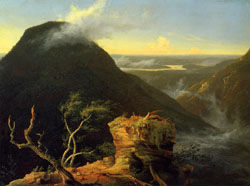 Picturesque. Rough, craggy trees and foliage, sharp contrasts of light and shadow. Emphasis is on variety and contrast rather than idealized nature. Since this aesthetic is between beautiful and sublime, it evokes a sense of reality of the landscape. It can stimulate the mind and imagination. An example is Thomas Cole's "Sunny Morning on the Hudson River" (pictured to the right).
Picturesque. Rough, craggy trees and foliage, sharp contrasts of light and shadow. Emphasis is on variety and contrast rather than idealized nature. Since this aesthetic is between beautiful and sublime, it evokes a sense of reality of the landscape. It can stimulate the mind and imagination. An example is Thomas Cole's "Sunny Morning on the Hudson River" (pictured to the right).
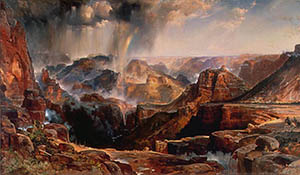 Sublime. Vastness, terror. World of darkness and storm. Tremendous mountains, deep valleys, storms. The sublime is also a term that implies an association with God and nature. Deists believe that in nature we can see God most clearly. An example is Thomas Moran's "Chasm of the Colorado" (pictured to the right).
Sublime. Vastness, terror. World of darkness and storm. Tremendous mountains, deep valleys, storms. The sublime is also a term that implies an association with God and nature. Deists believe that in nature we can see God most clearly. An example is Thomas Moran's "Chasm of the Colorado" (pictured to the right).
Painters
Let's look at some important painters of early America who are known for their representations of wilderness.
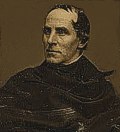 THOMAS COLE (1801- 1848) Transcendental Generation. Generational Type: Idealistic
THOMAS COLE (1801- 1848) Transcendental Generation. Generational Type: Idealistic
Thomas Cole was born in England and came to US when 17 years old. He settled in the upper Ohio valley. Eventually, Cole began traveling through wild areas and painting them. In his paintings, he broke with tradition and left out men and women - and the signs of human habitation. That makes sense since he was a member of Transcendental generation, an Idealist type generation, and would be willing to forge a new path. He lived during a time of a spiritual awakening, and you can sense that in his work. He painted in the picturesque style.
One way of summing up his work is a poem he wrote called "The Wild"
Friends of my heart, lovers of nature's works,
Let me transport you to those wild, blue mountains
That rear their summits near the Hudson's wave;
Though not the loftiest that begirt the land,
They yet sublimely rise, on their heights
Your soul may have a sweet foretaste of heaven
The two themes found in the poem (the landscape and heaven) are found in his work.
Since he painted in the Hudson River area, his work and others that followed them became known as the Hudson River School of painting. Members of the Hudson River School are landscape artists that broke with traditions of Claude Lorrain. They were greatly influenced by Romantic movement and found much of their inspiration in nature.
Cole often established a viewpoint for his paintings from a location that allows one to look down upon the scene and experience untrammeled nature as if it were suddenly unveiled. To provide perspective, he sometimes included small forms and figures. He is famous for placing gnarled and twisted trees in the foreground. He loved trees and imagined human likeness in their sensuous trunks and intertwining branches. His use of trees, along with rough and tangled brush and craggy mountains, helped accent the wild nature of the landscape.
Nature, to Cole, was an anecdote to the scourges of industrialization and urbanization which were replacing the quiet, pastoral lives of Americans. During his lifetime, the pace of development was ever accelerating. Business interests were exploiting the country side: from 1816-1840: 3,000 miles of canals were built. In the 1830's 2,000 miles of railroads were built. Cole didn't like cities. To him, they were squalid and vile places. But natural areas, as Cole wrote, had the "sweet foretaste of heaven."
His paintings . . .
Sunny Morning on the Hudson River. 1827, Oil. View Painting Here.
The early morning rays of the sun illuminate a rocky outcrop of wind scoured trees and brush. You can see in this painting Cole's fascination with the contrasts of light and darkness (which he may use to symbolically embody life and death). The eye is immediately drawn to the outcrop, dramatically cast in sunlight and standing out from the deep shadows of the background. Much of the rest of the scene is lightly shadowed except for a dabble of light on a far hillside and the reflection of the Hudson River far below.
Cole loved early morning scenes. The beginning of the day, the touch of light from the early morning sun, was a time of renewal, a lifting one's spirits. Conversely, sunset and evening to him were a somber times. He rarely painted sunsets.
In this work, Cole has clearly painted a wild landscape, but there's little feeling of being hemmed in - rather, the ample sky, its lightness and the viewer's high perspective all combine to allow one to enjoy the magnificent scene without being thrust into it.
Landscape with Tree Trunks. 1828, Oil. View Painting Here.
In one of his most compelling works of the late 1820's, Cole has positioned the viewer lower on the canvas, slightly behind a lake, its placid surface just beginning to glow with the reflection of a distant mountain.
In many of his paintings, Cole established a viewpoint from a high or moderately high position, looking down upon the scene, but here he has reversed things. The lower perspective more solidly brings the viewer into the scene. It is as if we are there with Cole, watching in awe as the early morning sunlight streams through a gap in a nearby ridge, and suddenly, to our right, a battered and twisted snag comes alive, the light exposing its surfaces and textures in stunning relief.
Cole was especially taken by trees. "They spring from some resemblance to human form," wrote Cole in verse describing trees. "There is an expression of affection in the intertwining branches - of despondency in the draping willow."
Cole's (and other Hudson River artists') use of gnarled and twisted trees wasn't lost on Henry David Thoreau. In Walden, he called them "blasted" trees. Before Thoreau began building his cabin in woods, he gave careful consideration to location, making sure that "each blasted tree could seen to the best advantage":
"The future inhabitants of this region, wherever they may place their houses, may be sure that they have been anticipated. An afternoon sufficed to lay out the land into orchard, wood-lot, and pasture, and to decide what fine oak or pine should be left to stand before the door, and whence each blasted tree could be seen to the best advantage." -- Henry David Thoreau, Walden
The Course of Empire: 1836, Oil. The "Course of the Empire" consists of a series of five paintings: Savage State, Pastoral State, Consummation of the Empire, Destruction, and Desolation.
As you view the series, you'll notice that the sun rises, then moves across the sky. Finally, in the last painting, it has set and is replaced by a dim moon partially obscured by shreds of clouds and reflecting eerily off the water.
Cole's belief in the purity of morning is apparent in the first two paintings which depict the loveliest, most harmonious scenes of all five paintings. Cole was an artist of the Romantic movement, and, as a Romantic, he believed in primitivism, the idea that nature and primitive culture are superior to civilization. It's no coincidence that his most pleasing images are in the morning hours.
His least favorite time was evening, and that, too, is apparent. The next to the last painting named "Destruction" occurs late in the day, and in the mournful "Desolation," the last of the series, evening has arrived.
Although the foreground scenery changes with each painting, you'll notice one feature that remains ever present in the background: a mountain. Cole may be using it as an artistic device, a reminder that while man wreaks havoc on nature, the land, itself, endures.
Cole chose something from Byron to describe the series of paintings (Byron, as I've mentioned before, was a leading figure in the Romantic movement).
There is the moral of all human tales
'Tis but the same rehearsal of the past
First Freedom, and then Glory: when that fails
Wealth, vice, corruption
(This is from Canto IV of Byron's "Cilde Harold" )
It's clear that Cole was using "The Course of the Empire" to make a statement about American civilization. If we remove ourselves too far from our primitive roots, if we become too obsessed with the creation of a great civilization, then we, too, are doomed to the "same rehearsal of the past."
The Oxbow. 1836. Oil. View Painting Here.
In this fascinating and highly symbolic painting, Cole depicts two landscapes: a wilderness on the left and cultivated fields on the right. Our view is from above, just behind one of Cole's favorite forms: a windswept and battered tree.
The tree is illuminated by the sun, but not with the same intensity and sharp contrast as in other paintings by Cole. Yet the tree is a vital compositional element, providing balance, and its sloping outward profile has the effect of drawing the eye toward the oxbow and the river valley below. There's also movement in that same direction with the advance of storm clouds from the mountainous wilderness.
Cole was a purist and seldom mixed wilderness and civilization, but here he may be using his art to reason that both are mutually beneficial. Life-giving rain and clean water needed by farms and the people below originate from wild unspoiled lands. Thus, man's future rests on keeping the balance between the two - just as he has balanced the painting by the compositional elements of both wilderness and civilization.
This is the ideal: civilization in the form of small farms and sparsely populated rural areas, but that's as far as Cole is willing to take it. He's clearly not willing to accept that large towns and cities are beneficial to humanity - or to one's spiritual life. When we discuss Thoreau we'll see that the two men clearly agreed on that point. It's only in nature, far away from the clamor and corruption of cities, that we can establish a close and intimate relationship with the divine.
Schroon Mountain, Adirondacks. 1838, Oil. View Painting Here.
When Schroon Mountain is compared to many of Thomas Cole's wilderness paintings, the landscape here is more open, less constricted and less shadowed. Combined with the use of warm colors, it creates a lighter, more welcoming ambiance. His distinctive twisted and gnarled trees are there in the foreground: one tree leads the eye upwards toward the right ridge, and the other accomplishes the same towards the left ridge - all lines joining at the pyramidal summit of the mountain.
The mountain, itself, is only lightly shadowed. It doesn't loom dark and menacingly, and its lower slopes are illuminated by scattered rays of sun - particularly between the two prominent foreground trees - which highlight the reds and golds of fall foliage. This is still clearly wilderness. It's not a pastoral outdoor scene that might be painted by an Old World artist, but Cole's brush strokes have fashioned an inviting wilderness where one is drawn in by the colors, beauties and forms of the natural world.
FREDRICK CHURCH -- Just a quick mention because you are bound to see his name. We won't study him here but he is another famous landscape artist of the Hudson River School of painting.
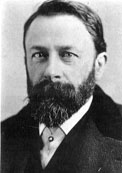 ALBERT BIERSTADT (1830-1902) Gilded Generation Generational Type: Reactive.
ALBERT BIERSTADT (1830-1902) Gilded Generation Generational Type: Reactive.
(The Gilded generation takes things a step further. Cole painted the East. Albert Bierstadt went west. )
Bierstadt was born in Germany. His family brought him to the US when he was two years old. He became a painter, and to supplement his income, he taught painting. In 1859, he joined the survey team of Colonel Fredrick W. Lander who was working on what became known as the "Lander Road" an alternative route of the Oregon trail from South Pass to Fort Hall. After returning from the Lander Survey, he re-worked his sketches into paintings which sold quite well. In 1863, he traveled west and visited Yosemite Valley. In 1864 "The Rocky Mountains" exhibit brought him immediate fame.
His paintings . . .
Wind River Country. 1860, Oil. View Painting Here.
In this scene, Bierstadt has captured that fascinating stretch of land that rises from valley's edge to the high mountains. This is not nature as a backyard garden. This is clearly wilderness: the view is expansive, no where can be seen a sign of man - and just to make sure you haven't missed the artist's intention: a bear is eating its kill in the left foreground.
While this is wilderness pure and simple, Bierstadt hasn't imbued the painting with the qualities of the sublime: the color palette lends warmth to the scene and there is nothing fearsome and dangerous about it.
The rugged, snow-covered mountains which could represent danger are way in the distance and only add to the overall beauty of the scene. Elk drink from the river. The bear, though it represents a state of wildness, is not unduly intimidating and almost blends in with the scenery. There is a balance of trees and open grasslands, gentle lands and rocky outcroppings. You almost want to curl up under one of the trees, lay back and soak it all in - that is, as long as you can stay a respectful distance away from the bear.
Yosemite Valley. 1866, Oil. View Painting Here.
Yosemite was one of Bierstadt most beloved subjects, and he made many paintings of it. Although the valley was still very much in a wild, primitive state, in this painting, Bierstadt portrays the valley as orderly and park-like. He has eliminated clutter, keeping the elements of the painting to only the essentials. The painting is balanced beautifully by positioning the foreground trees on the left and the mountain massif in the right background.
Buffalo Trail. 1867-68, Oil. View Painting Here.
This lovely painting by Albert Bierstadt portrays a buffalo herd crossing a river. If you look carefully, you can see that the string of buffalo is endless, curving beyond the river, trailing off and vanishing in the distance.
Compositionally, the center of the painting is wonderfully anchored by the two bright and matching ovals of river and sky. Like a number of his Yosemite paintings, Bierstadt restricted this scene to the essential elements. This is very much an Eden. The clouds, the suffused light of the sky and the reflective glow of the water show the American west from a romantic perspective.
Bierstadt is a part of the Hudson River School of landscape painting. Thomas Cole who we have studied was the founder of the Hudson River School. He and Cole had differing opinions on light. Bierstadt was enchanted with evening light. Cole, on the other hand, was fascinated with early morning light and associated evening light with feelings of melancholy. But not Bierstadt. To him, evening light unlocked the secrets of the landscape, baring the very soul of nature. In Buffalo Trail, Bierstadt has clearly unlocked some of those secrets.
Sierra Nevada. 1872, Oil. View Painting Here.
Bierstadt has approached this painting in a different manner than many of his mountain scenes. He often uses ponds, lakes and other water features to anchor the foreground elements of the painting, but here we find ourselves in the midst of the Sierra Mountains. Bierstadt may be trying to convey the impression that you might be faced with as you travel through the Sierras: you top over a ridge, and, suddenly, you find yourself immersed in a mountain wilderness.
Lower Yellowstone Falls. 1880, Oil. View Painting Here.
Bierstadt did not visit Yellowstone until 1880. Although he did some paintings of the area, it didn't inspire him like Yosemite and other scenic areas of the west. This painting of Lower Yellowstone Falls, while portraying the beauty and wildness of the first national park, is darker, more monochromatic, and doesn't capture the subtle colors of the canyon as Moran's famous painting of the same subject.
Hetch Hetchy Valley View Paintings Here.
Hetch Hetchy Valley, located slightly north of Yosemite, is a smaller version of Yosemite, yet it was equally spectacular with waterfalls and soaring granite walls. The controversy to build a dam in Hetch Hetchy Valley was the first great national conservation battle. The battle was lost, and Hetch Hetchy is now under a reservoir created by the O'Shaughnessy Dam. These paintings by Bierstadt show what the valley looked like before the dam
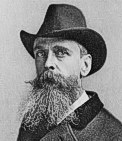 THOMAS MORAN (1837-1926) Gilded Generation
THOMAS MORAN (1837-1926) Gilded Generation
Thomas Moran's and Thomas Cole's backgrounds were similar in some respects. Both came from ugly, industrialized areas of England. Both emigrated in their youth: Moran emigrated when he was 7 and Cole when he was 17.
Moran began by apprenticing to an engraving firm. He sold a few water colors on the side, and with this modest success he started a small studio. He traveled to and studied in Europe which in those days was considered essential to being a real artist. He sold more paintings and by the close of the 1860's, Moran was well on his way to becoming a known landscape artist in the Hudson River School, painting the wilderness of the Eastern US.
Moran's break came when he started working for Scribner's Monthly. An article had been written about Yellowstone, and from primitive sketches, Moran made engravings for the article. His engravings caught the attention of geologist Dr. Ferdinand Hayden who was organizing an expedition to Yellowstone and who subsequently invited Moran on the expedition.
Known as the Hayden expedition, they traveled by rail to Green River, stagecoach to Virginia City, Montana, and then horseback to Yellowstone. William Henry Jackson, the photographer, was also on that 1871 trip.
On the expedition, Moran did both watercolors and oils. Moran's style in his Yellowstone watercolors "pulls viewer into a miniature world of suggested immensity. The 'Paintings' small scale and delicacy of color and brushwork are strangely appropriate to comprehending the vast distances and remarkable geography."
His paintings . . .
Grand Canon of the Yellowstone (1872, Oil). View Painting Here.
"Grand Canyon of the Yellowstone" is one of Thomas Moran's most famous works. The unveiling of this magnificent and prodigious, seven-by- twelve foot canvas caused quite a stir in May 1872. Purchased by the U.S. Government, it was the first landscape painting to hang in the halls of Congress.
Moran spent considerable effort trying to portray the colors and geological features accurately, even to the extent having geologist Ferdinand Hayden review his work before completion. He was, however, an artist and he manipulated the painting to achieve his own ends.
"While I desired to tell truly of Nature," Moran wrote, "I did not wish to realize the scene literally, but to preserve and to convey its true impression." In that effort, to convey its beautify, grandeur and immensity, Moran was, indeed, extraordinarily successful.
Chasm of the Colorado (1873, Oil) View Painting Here.
In 1872, John Wesley Powell asked Thomas Moran to join his survey of the Grand Canyon. Moran declined that first overture and went to Yosemite instead. He wasn't as artistically stimulated with Yosemite's landscape as he was with Yellowstone's, but he did do some work there. By the following year Moran was ready to paint the Grand Canyon and took Powell up on the offer.
His trip to the Grand Canyon was more fodder to his rising star, associating him with another explorer of the post civil war period. His first association had been with Ferdinand Hayden (explorer of Yellowstone, Tetons and the Colorado Rockies), and now he was cementing a relationship with an explorer, even more famous, who had led the first descent of the Colorado River through the Grand Canyon. The relationship would would be a mutually beneficial for both men. The two would continued to work together with Moran providing illustrations for Powell's reports over the next few years.
After visiting the Grand Canyon in 1873 and making sketches, Moran returned to the East. Using his sketches, and aided by photographs provided by Powell, he spent the winter painting in his studio.
The result, the "Chasm of the Colorado," is as impressive in size as it is artistically. It measures 7 x 12 feet, and like Moran's Yellowstone painting, it was wildly successful.
As you view the painting, you'll see that Moran has positioned the viewer under the rim of the canyon, on a ledge high above what may or may not be the river. The depths are so great and dark that's it's difficult to tell whether the river can be seen or not. Beyond the viewpoint, in the recesses below, the Canyon turns and angles away in the distance.
A few rocks and plants in the foreground help provide perspective of the immense scale encompassed by the painting. A squall passing over the canyon leads the eye downward into its depths from which mist rises and hovers along the edges of ravines and precipitous side canyons. This is a vast and almost unfathomable scene: a place of where the heavens mix with a great rent in the face of the earth. This is not an Eden. There are no balanced or comfortable forms nor soft, golden light. It is raw, unrestrained nature. It is what, in the 19th century, was called sublime: an intimidating landscape of great and terrible depths, of fearsome heights, of storms and of danger just a step away from the edge.
Sublime and profitable. Moran's monumental work of the Grand Canyon became the second of his paintings to be purchased by Congress. He received the princely sum of $10,000, and the painting was hung in the Senate lobby along with his painting of Yellowstone canyon.
Powell, who introduced Moran to the canyon and who knew it better than anyone, from the river and rim, gushed with praise when he saw the finished painting:
"It required a bold hand to wield the brush for such a subject. Moran has represented the depth and magnitudes and distances and forms and color and clouds with great fidelity, but his picture not only tells the truth. The somber shadow in the foreground, the light in the distance, the great clouds that roll in the gulches, the cloudlets that hide in the chasms and creep along the face of the cliffs - all of these features and many others so are so arranged as to give a most vivid and grand picture." --John Wesley Powell
Mount of Holly Cross. (1875, Oil). View Painting Here.
The Mount of the Holy Cross was first discovered in the late 1860s and since has attracted considerable interest because of its religious symbolism. During the summer, snow tends to remain in shaded features of the mountain, and viewed from the right perspective, it appears as a thin white cross.
During the 1920s and 30s, hundreds of religious pilgrims came to see the mountain. Moran's paintings very likely added to the mountain's popularity. He first traveled to the mountain, long before the pilgrimages began, in 1874. He started with a watercolor, did an oil version (shown) above in 1875, eventually completing four paintings of the mountain.
While the general shape of the mountain is correct, the topography is a bit disjointed. Moran shows a rushing stream in the foreground, but, in reality, only part of the mountain can be seen from the stream, certainly not the cross. But, alas, photo perfection was not his purpose. Moran fully admitted that he didn't paint literally. He was an artist, an interpreter of landscapes, each brush stroke a measured balance between the real and the imagined.
Ruby Range (1879, Watercolor). View Painting Here.
In 1879 Thomas Moran accepted an offer from the Union Pacific Railroad whereby he traveled and painted landscapes of the scenery along the UP line. This watercolor of the Ruby Range in Nevada is one example. If you ever drive through Nevada in late summer, take a glance at the mountain ranges as they pass by the window, and my guess is that you'll see something of Moran's painting in nearly every one.
Shoshone Falls (1874-75, Oil). View Painting Here. I've included this work by Moran since it's one of the very few of the Idaho landscape. Shoshone Falls still exists, but whether you can view the falls or not depends upon water availability. A good portion of the Snake River's water is removed upriver for irrigation purposes. When there is enough of a run-off, however, it's worth a trip to Twin Falls to view the falls from the overlook on the canyon's south side.
The scene won't quite be like Moran's painting which also views the falls from the south side. You'll see that the north side of the canyon is now cluttered with a power station and transmission wires and towers. Nonetheless, when the river is full, and the water thunders over the edge, and the canyon is filled with spray -- and when the sky blackens with the coming of a late afternoon storm -- you're likely to see and remember an image not unlike Moran's.
Traveling to the Tetons. I don't have any good representations of Moran's Teton paintings, but I did want to include some material on this aspect of his life. That's because when we think of Moran, we immediately imagine a close association with him and the Tetons. One of the peaks in the Teton Range, and the most impressive of the northern summits, is named Mt. Moran. It was named in Moran's honor by the explorer Ferdinand Hayden in 1872.
In the late 1870's Moran had yet to see the Tetons, but the opportunity finally came in 1879 while travelling on his Union Pacific Railroad contract. He made way back through Utah and Idaho. To get to the Tetons, he was accompanied by a military escort. He described the journey through hostile Indian country as dry, dusty, windy and rife with fires.
Unfortunately, he never got around to the Jackson Hole side. He viewed the Tetons from the Idaho side. If you've ever looked at Mt. Moran from the Idaho side, you'll know it's not the best side for viewing. He did manage to make some sketches, and eventually made some paintings (one of which hangs in the Oval Office of the White House), but he never saw the mountain that was named after him from its most dramatic, eastern-side perspective. (What does it look like from the east side? Here's William Henry Jackson famous photograph taken in 1872: Mt Moran)
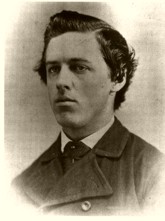 WILLAM HENRY JACKSON (Progressive Generation, but just barely) 1843-1942.
WILLAM HENRY JACKSON (Progressive Generation, but just barely) 1843-1942.
Jackson started his career in 1864 as a photographer's assistant in Vermont. He was fascinated with the west. He first went to California in 1866. On this journey, he worked as a bull bullwhacker, running a wagon carrying 8,000 pounds of goods pulled by 12 massive oxen. To get to California, he and his companions followed Oregon Trail to Salt Lake City. There he joined a different wagon train, eventually reaching California. In 1867, he reversed course, driving horses from California to Nebraska. Afterwards, he settled down to photographic work in Omaha. His big break as a photographer came in 1870 when Ferdinand Hayden invited him on his expedition to Yellowstone, the same one Thomas Moran was on.
His photographs . . .
Mammoth Hot Springs (1871) View Photograph Here.
It was Ferdinand Hayden's 1871 expedition to Yellowstone which brought William Henry Jackson to the forefront of American photography. Jackson served as the expedition's photographer, and Hayden couldn't have been more pleased with the results. Photography was no easy task in the 1800s, and it was vastly more difficult when it was done in a wilderness setting. The heavy camera, tripod, glass plates, bottles of chemicals, development box, and assorted photographic equipment had to be carried first by horse or mule and then on men's back. Once the camera was set up, snapping the picture was just the beginning. This is how Jackson described taking the above photo of Mammoth Hot Springs:
"The subject matter [Mammoth Hot Springs] close at hand was so rich and abundant that it was necessary to move my dark box only three or four times. My invariable practice was to keep it in the shade, then, after carefully focusing my camera, return to the box, sensitize a plate, hurry back to the camera while it was still moist, slip the plate into position, and make the exposure. Next step was return to the dark box and immediately develop the plate."
--William Henry Jackson in Time Exposure
Old Faithful (1871) View Photograph Here.
Jackson took a wealth of photographs for Ferdinand Hayden's 1871 Yellowstone expedition, including this one of Old Faithful. All in all, Hayden spent 40 days in Yellowstone. Jackson's photographs along with Thomas Moran's paintings would cause a sensation when they were displayed on the East coast the following year.
Mt. Moran (1872) View Photograph Here.
After his successful 1871 expedition to Yellowstone, Ferdinand Hayden organized an exploratory trip to the Teton Range the following year. Hayden named one of the mountains in the range after Thomas Moran who by now had established himself as a great American painter of the west. Jackson took this picture of Mount Moran.
Mount of the Holy Cross (1873) View Photograph Here.
Mount of the Holy Cross is located in the Colorado Rockies and was named for the thin white cross that appears on the side of the mountain as snow melts away in the summer. Jackson photographed the mountain, and Thomas Moran painted it.
Their work helped fuel an already budding fascination by the public in the symbolic significance of the mountain. (See also: Moran's painting.) In order to show the cross clearly, Jackson found that he had to climb a high ridge to get in just the right position and take his photographs in the morning when the sunlight cast just the right shadows.
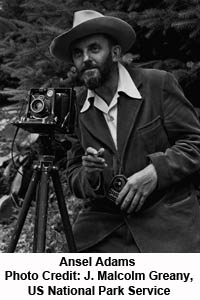 ANSEL ADAMS (GI Generation - Civic Type) 1902 - 1984
ANSEL ADAMS (GI Generation - Civic Type) 1902 - 1984
Ansel Adams was Born in San Francisco. As a teenager, he joined the Sierra Club and worked at the club's visitor center in Yosemite. He began taking photos and quickly developed an artful style and technique. At his death in 1984, he was one of the foremost photographers in the world. He is best known for his black-and-white photographs of the American West, especially Yosemite National Park.
Adams photographs and advocacy helped expand the National Park system. He skillfully used his images to promote the goals of the Sierra Club of which he became a guiding force. His photographs are still very popular in calendars, posters, and books.
He wrote: "We all know the tragedy of the dustbowls, the cruel unforgivable erosions of the soil, the depletion of fish or game, and the shrinking of the noble forests. And we know that such catastrophes shrivel the spirit of the people . . . . The wilderness is pushed back, man is everywhere. Solitude, so vital to the individual man, is almost nowhere."
Through his photography and his work with the Sierra Club, he helped protect some of that wild solitude that is so essential to spirt of humankind.
Photograph . . .
Moon And Half Dome (1960) View Photograph Here (Note: to assure that the copyright is fully protected, this link goes directly to a reproduction of the photograph on the Ansel Adam's Gallery site.)
"Moon And Half Dome" is one of the most famous images of Yosemite National Park and certainly the most famous of Half Dome. Adams wrote the following about the photograph:
"As soon as I saw the moon coming up by Half Dome I had visualized the image. I have photographed Half Dome innumerable times, but it is never the same Half Dome, never the same light or the same mood. Half Dome is a great mountain with endless variations of lighting and sky situations and seasonal characteristics; the many images I have made reflect my varied creative responses to this remarkable granite monolith."
Note that you can also view the paintings and brief explanations from the following link: Paintings
Pub History: This page was originally located at the following URL:
https://www.isu.edu/~wattron/OLNotes2.html
[End]
